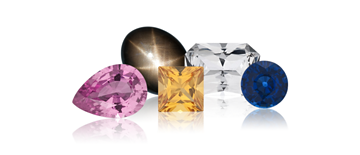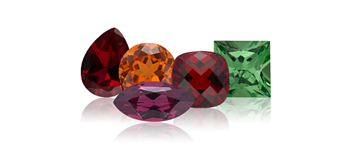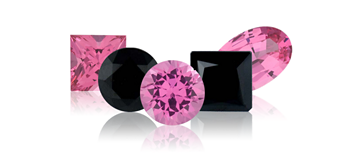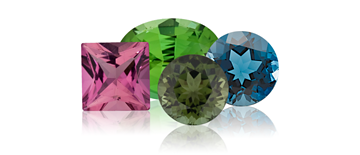Gemstones
Most often you will see engagement and wedding rings set with diamonds. At Visionary Jewelers you can chose to be unique by selecting a beautiful gemstone instead of a diamond!
The diamond is the hardest stone on the Mohs Hardness Scale [see below] and the most durable for every day wear, but many other gemstones can be selected. Our Graduate Gemologist can instruct you on any special care your selected gemstone requires. The choice is yours be it diamond, ruby, emerald, sapphire or other that suites your fancy!
Visionary Jewelers can also design that special right hand ring, pendant or earrings with your favorite gemstones!
Shown below are the most common gemstones selected other than a diamond.
Alexandrite
Alexandrite Named after Alexander II, Czar of Russia was discovered on this ruler’s birthday in the early 1830’s. Because of this, alexandrite was considered a stroke of luck and worn as an amulet of good fortune. A June birthstone, alexandrite also is the recognized gift for the 55th wedding anniversary. A rare form of the gem chrysoberyl, alexandrite changes color in different lighting. In daylight, it is emerald green, blue-green or pastel green. In incandescent light, it is violet, ruby red or purple. Its value is based on the limited quantity in which it is found, its size, clarity and quality of color change. Alexandrite is not typically enhanced.
Emerald
Emeralds are fascinating gemstones with the most beautiful, intense and radiant green color. It is the green variety of Beryl, a beryllium aluminum silicate mineral colored by trace amounts of chromium and/or vanadium. Its hues range from yellow-green to blue-green with the finest being a deep, lively green. Inclusions within the emerald are more tolerated than other gems; a medium to dark colored emerald has a much higher value than an almost flawless paler colored emerald.
Since ancient times, the emerald has been held in high esteem. Its name was first translated according to Indian lore from Sanskrit as Marakata, meaning “the green of growing things. Over time the Old French or Latin versions, Esmeraulde, Esmaralda or Esmaraldus became the current name.
Emerald is the birthstone of May and the gemstone for the 55th wedding anniversary. It is the sacred stone of the goddess Venus and is thought to preserve love. And the emerald has long been the symbol of hope. Fine emeralds are even more valuable than diamonds.
Opal
Described by the Ancient Romans as the “Queen of All Gems,” opal is a chameleon encompassing the essence of every gem in one. Its name means to see a change of color, which this “phenomenal” gem shows in unusual optical effects of shifting spectral hues described as play of color.
An October birthstone, opal is favored as a gift for the 14th wedding anniversary. Opal is revered as a symbol of hope, fidelity and purity. A gem of positive transformation, opal reveals the colorful attributes of those who wear it.
Opal occurs in several types; the most common is white opal with vibrant pastel flashes. Black opal has a blue, gray or black body with more dramatic color play. Boulder opal is black opal with some of the ironstone in which is occurs. Crystal opal is clear with glints of swimming color. Fire opal has a yellow, orange or red body with or without color play. Value is typically based on the brilliance and pattern of the play of color, as well as size, with larger gemstones being more valuable. Opals are commonly enhanced to improve durability and appearance, except fire opal.
Sapphire
Most commonly known for its shades of celestial blue, sapphire actually comes in almost every color but red, which is exclusive to its sister ruby in the corundum family. Next to diamond, sapphire is the second hardest gemstone, ideal for all types of jewelry, especially rings. September’s birthstone, sapphire is also the preferred gift for the 5th and 45th wedding anniversaries, historically symbolizing truth and promise keeping. In fact, sapphire is a popular gem choice for brides who want to express their unique personality.
Sapphire was believed to inspire peace, joy, wisdom and prosperity as well as good health and well-being. Gem of sincerity, sapphire illuminates the true inner beauty of those who wear it. Although the name is derived from the Latin word for blue, sapphirus, sapphire is actually available in yellow, peach, orange, cognac, pink, violet, purple and green, as well as colorless, white, gray and black. The purer the color of a natural sapphire, the greater the price it can command. Better quality sapphires are usually eye-clean.
Sapphires are routinely enhanced by traditional heating methods to produce, intensify or lighten color and/or improve clarity.
Zircon
Prized as a talisman since medieval times, zircon was believed to clarify the mind, improve confidence and inspire the spirit. Among its many attributes, zircon was thought to bring wisdom, wealth and protection to those who wear it.
Zircon is available in several colors including yellow, orange and green with blue and red most sought after and brown most available. Brown zircon is commonly enhanced by traditional heating methods to produce red and blue colors while yellow is occasionally heated to improve its color. Green zircon is not typically enhanced.
Amethyst
Amethyst revered by the ancient Greeks as a talisman was thought to entice the highest, purest aspirations of humankind when worn. Amethyst was believed to inspire courage, calm and contemplation. February’s birthstone, amethyst also is the favored gift for the 1st and 6th wedding anniversaries, historically symbolizing sincerity and sacred love. Gem of optimism and good fortune, amethyst reveals the positive vibrations surrounding those who wear it. A member of the quartz family, amethyst comes in a variety of purple shades of varying intensity from pale lilac to reddish or bluest violet to deep purple with red highlights.
Amethyst is considered the most highly prized variety of quartz, although very affordable. Amethyst is sometimes enhanced by traditional heating methods to lighten color and remove smoky component. Certain amethysts are heated to produce citrine and green quartz.
Garnet
Gem of plenty, garnet is one of the few gem varieties that spans a broad spectrum of color. Named for its likeness to pomegranate seeds, garnet is best known for its shades of red. But most are surprised to learn that garnet is found in multiple hues of pink, purple, green, yellow, orange and brown.
January’s birthstone, garnet is also the suggested gift for the 2nd wedding anniversary. Known as the gem of commitment, garnet has historically signified faith, friendship, loyalty and truthfulness. Believed to calm anxiety, cheer the heart, encourage guidance and inspire creativity, garnet illuminates the bright disposition of those who wear it.
A majority of the garnet varieties can be classified as one or a mixture of five types: Almandine, the most common type, is dark red to brownish-red. Pyrope is a deep, vivid red. A blend of pyrope and almandine is rhodolite, a light to dark pink to purplish red. Andradite comes in yellow, green or brown, known as demantoid when emerald in color. Grossular garnet comes in yellow, orange and brown, known as tsavorite in its green variety and hessonite when cinnamon colored. Spessartite comes in shades from reddish-brown to yellow orange.
Lively, bright colors usually command higher prices in better qualities of garnet that are typically eye-clean. Rhodolite, particularly in its reddish colors, and spessartite [see below] in bright orange red, are uncommon and considered more valuable, with the rarest garnets recognized as tsavorite and demantoid. Garnets are typically not enhanced.

Spessartite is a form of garnet with an unusually high refractive index, which helps to make this radiant orange/red gemstone a very brilliant stone. Spessartite garnet was originally named after the site of a find in Germany and until 10 years ago was a very rare stone. Recent discoveries in Africa and Madagascar have substantially increased its availability
Peridot
Prized by the ancient Egyptians as the gem of the sun, peridot has been credited with a host of healing properties and magical powers. A guard against the evil eye, peridot was thought to sweeten dreams and reveal insights.
August’s birthstone, peridot is also recognized as the preferred gift for the 16th wedding anniversary. Historically, peridot was believed to bring happiness, attract love and foster friendship. Gem of bliss and good fortune, peridot illimunates the sunny disposition of those who wear it.
A volcanic gem, peridot varies in color from yellowish green to deep olive. While its color can be exceptional, it will never reach the shade of green or intensity characteristic of emerald. The finest peridot is green with no tinge of yellow or brown. Peridot comes in a variety of shapes and small sizes, but larger gemstones, especially in flawless quality, are difficult to find. Peridot is not routinely enhanced.
Spinel
Spinel Centuries ago in Sanskrit writings was called the daughter of ruby, adored yet somehow different. The Crown Jewels of Great Britain are graced with spinels and have resided in the regalia of kingdoms throughout history. It is now the third birthstone of August.
Found in Myanmar (Burma) and Sri Lanka, spinel comes in a variety of colors including oranges, pinks, blues, lavenders, mauves and vivid reds. While common in sizes up to 2 carats, larger gemstones can also be acquired.
Spinel is thought to protect the owner from harm, reconcile differences and to soothe away sadness. However, the strongest reasons for buying a spinel are its rich, brilliant array of color. Spinel is a durable gemstone that is perfect for all jewelry uses.
Aquamarine
Aquamarine is derived from the Latin word aquamarina, meaning seawater, aquamarine is known as the gem of the sea. It was believed to keep sailors safe and guard against storms as well as bring hope, health, harmony and happiness.
March’s birthstone, aquamarine is also the recognized gift for the 18th wedding anniversary, believed to reawaken love, kindle friendships and elevate the spirit. Gem of youthful outlook, aquamarine glints the fresh, young-at-heart qualities of those who wear it.
Sister to emerald and a member of the beryl family, aquamarine is known for its range of serene, oceanic shades from pastel to medium light blue-green or light green to a deep blue. Even aquamarine’s blues have a green tinge. The color of aquamarine can be quite intense in larger sizes, while it is often less vivid in smaller ones. Differences in shade and depth of color have an effect on its value. A gem that is a deep blue and without inclusions is considered the most valuable.
Aquamarine is routinely heated to remove yellow components.
Ruby
Believed to burn with an inextinguishable internal fire, ruby has historically signified great passion. This fiery red gem, the color of the heart has always been associated with deep love. Also the color of blood, ruby signifies great courage. Next to diamond, ruby is the second hardest gemstone, ideal for all types of jewelry, especially rings.
July’s birthstone, ruby is also recognized as the traditional gift for the 15th and 40th wedding anniversaries. Historically, ruby was believed to attract and maintain love. In fact, ruby is a popular gem choice for brides who want to express their unique personality.
Ruby is recognized as a talisman to ensue harmony, guard against sorrow, inspire confidence, and bring success. Gem of gusto, ruby brings to light the electrifying personality of those who wear it.
This corundum family gem, sister to sapphire, only comes in one color. But, the shades of red in which it comes vary from purplish and bluish red to orangey red in medium to dark tones. Color is key when considering value. Prized colors are pure red with no overtones of brown or blue. Better qualities are usually eye-clean.
Rubies are routinely enhanced by traditional heating methods to produce, intensify or lighten color and/or improve clarity.
Tormaline
Perhaps the most diverse gemstone available, tourmaline possesses a dazzling array of colors. Moreover, there are bi-colored and tri-colored tourmalines where two or more colors appear side by side in the same gemstone.
An October birthstone, tourmaline is also the chosen gift for the 8th wedding anniversary. Tourmaline is esteemed as a gem of enlightenment and resolution. Believed to foster compassion, composure and reflection, tourmaline reveals the most captivating characteristics of those who wear it.
The name tourmaline means multi-colored, a modest description of the variety that exists in this mineral family which includes dark green chrome tourmaline, deep blue to blue-green indicolite, pink to deep red rubellite and watermelon tourmaline. Color determines price, with lively, mid-colored gems valuable.
Tourmalines are commonly enhanced by traditional heating methods.
| Gemstone | Hardness |
|---|---|
| Diamond | 10 |
| Ruby | 9 |
| Sapphire | 9 |
| Star Ruby | 9 |
| Star Sapphire | 9 |
| Color-Change Sapphire | 9 |
| Chrysoberyl Cat's Eye | 8.5 |
| Alexandrite | 8.5 |
| Chrysoberyl | 8.5 |
| Topaz | 8 |
| Rutile Topaz | 8 |
| Azotic Topaz | 8 |
| Mystic Topaz | 8 |
| Spinel | 8 |
| Imperial Topaz | 8 |
| Emerald | 7.5 - 8 |
| Andalusite | 7.5 |
| Hambergite | 7.5 |
| Aquamarine | 7.5 - 8 |
| Goshenite | 7.5 - 8 |
| Cat's Eye Aquamarine | 7.5 - 8 |
| Beryl | 7.5 - 8 |
| Morganite | 7.5 - 8 |
| Demantoid Garnet | 7 - 7.5 |
| Quartz Cat's Eye | 7 |
| Amethyst | 7 |
| Cat's Eye Tourmaline | 7 - 7.5 |
| Smoky Quartz | 7 |
| Quartz | 7 |
| Tourmaline | 7 - 7.5 |
| Star Lemon Quartz | 7 |
| Rose Quartz | 7 |
| Ametrine | 7 |
| Kunzite | 7 |
| Citrine | 7 |
| Mystic Quartz | 7 |
| Paraiba Tourmaline | 7 - 7.5 |
| Danburite | 7 - 7.5 |
| Strawberry Quartz | 7 |
| Aventurine | 7 |
| Rutile Quartz | 7 |
| Chrome Tourmaline | 7 - 7.5 |
| Dumortierite Quartz | 7 - 8.5 |
| Iolite | 7 - 7.5 |
| Rubellite Tourmaline | 7 - 7.5 |
| Tanzanite | 6.5 - 7 |
| Peridot | 6.5 - 7 |
| Mali Garnet | 6.5 - 7.5 |
| Jasper | 6.5 - 7 |
| Axinite | 6.5 - 7 |
| Chrysoprase | 6.5 - 7 |
| Fossil Coral | 6.5 - 7 |
| Dendritic Agate | 6.5 - 7 |
| Spessartite Garnet | 6.5 - 7.5 |
| Fire Agate | 6.5 - 7.5 |
| Tiger's Eye | 6.5 - 7 |
| Grossularite Garnet | 6.5 - 7.5 |
| Agate Geode | 6.5 - 7 |
| Star Rose Quartz | 6.5 - 7 |
| Ruby-Zoisite | 6.5 - 7 |
| Star Garnet | 6.5 - 7.5 |
| Idocrase | 6.5 |
| Color-Change Garnet | 6.5 - 7.5 |
| Hiddenite | 6.5 - 7 |
| Agate | 6.5 - 7 |
| Melanite | 6.5 - 7 |
| Zircon | 6.5 - 7.5 |
| Color-Change Diaspore | 6.5 - 7 |
| Bloodstone | 6.5 - 7 |
| Hessonite Garnet | 6.5 - 7.5 |
| Tiger's Eye Matrix | 6.5 - 7 |
| Cat's Eye Diaspore | 6.5 - 7 |
| Spodumene | 6.5 - 7 |
| Tsavorite Garnet | 6.5 - 7.5 |
| Almandine Garnet | 6.5 - 7.5 |
| Peanut Wood | 6.5 - 7 |
| Onyx | 6.5 - 7 |
| Carnelian | 6.5 - 7 |
| Pyrope Garnet | 6.5 - 7.5 |
| Chalcedony | 6.5 - 7 |
| Rhodolite Garnet | 6.5 - 7.5 |
| Sillimanite Cat's Eye | 6.5 - 7.5 |
| Andesine Labradorite | 6 - 6.5 |
| Star Moonstone | 6 - 6.5 |
| Prehnite | 6 - 6.5 |
| Labradorite | 6 - 6.5 |
| Rainbow Moonstone | 6 - 6.5 |
| Rainbow Pyrite | 6 - 6.5 |
| Sunstone | 6 - 6.5 |
| Moonstone | 6 - 6.5 |
| Sugilite | 6 - 6.5 |
| Clinohumite | 6 |
| Maw-Sit-Sit | 6 - 7 |
| Cassiterite | 6 - 7 |
| Kyanite | 6 - 7 |
| Star Sunstone | 6 - 6.5 |
| Jadeite | 6 - 6.5 |
| Nephrite Jade | 6 - 6.5 |
| Orthoclase | 6 - 6.5 |
| Amazonite | 6 - 6.5 |
| Cat's Eye Scapolite | 5.5 - 6 |
| Moss Opal | 5.5 - 6.5 |
| Hematite | 5.5 - 6.5 |
| Nuummite | 5.5 - 6 |
| Moldavite | 5.5 |
| Opal Doublet | 5.5 - 6.5 |
| Fire Opal | 5.5 - 6.5 |
| Rhodonite | 5.5 - 6.5 |
| Scapolite | 5.5 - 6 |
| Boulder Opal | 5.5 - 6.5 |
| Opal | 5.5 - 6.5 |
| Sodalite | 5.5 - 6 |
| Hackmanite | 5.5 - 6 |
| Sphene | 5 - 5.5 |
| Lapis Lazuli | 5 - 6 |
| Tremolite-Hexagonite | 5 - 6 |
| Hemimorphite | 5 |
| Star Diopside | 5 - 6 |
| Smithsonite | 5 |
| Cat's Eye Apatite | 5 |
| Turquoise | 5 - 6 |
| Snowflake Obsidian | 5 - 5.5 |
| Apatited | 5 |
| Chrome Diopside | 5 - 6 |
| Obsidian | 5 - 5.5 |
| Tashmarine Diopside | 5 - 6 |
| Larimar | 4.5 - 5 |
| Gaspeite | 4.5 - 5 |
| Charoite | 4.5 - 5 |
| Rhodochrosite | 4 |
| Variscite | 4 - 5 |
| Ammolite | 4 |
| Fluorite | 4 |
| Azurite | 3.5 - 4 |
| Malachite | 3.5 - 4 |
| Sphalerite | 3.5 - 4 |
| Calcite | 3 |
| Coral | 3 - 4 |
| Verdite | 3 |
| Lepidolite | 2.5 - 3 |
| Pearl | 2.5 - 4.5 |
| Chrysocolla | 2 - 4 |
| Seraphinite | 2 - 4 |
| Amber | 2 - 2.5 |











